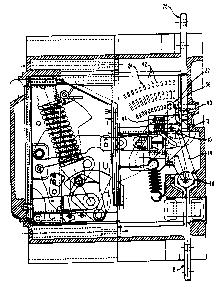Une partie des informations de ce site Web a été fournie par des sources externes. Le gouvernement du Canada n'assume aucune responsabilité concernant la précision, l'actualité ou la fiabilité des informations fournies par les sources externes. Les utilisateurs qui désirent employer cette information devraient consulter directement la source des informations. Le contenu fourni par les sources externes n'est pas assujetti aux exigences sur les langues officielles, la protection des renseignements personnels et l'accessibilité.
L'apparition de différences dans le texte et l'image des Revendications et de l'Abrégé dépend du moment auquel le document est publié. Les textes des Revendications et de l'Abrégé sont affichés :
| (12) Brevet: | (11) CA 1331035 |
|---|---|
| (21) Numéro de la demande: | 1331035 |
| (54) Titre français: | DISJONCTEUR A COMMUTATION D'ARC |
| (54) Titre anglais: | ARCING CONTACT ASSEMBLY FOR A CIRCUIT BREAKER |
| Statut: | Périmé et au-delà du délai pour l’annulation |
| (51) Classification internationale des brevets (CIB): |
|
|---|---|
| (72) Inventeurs : |
|
| (73) Titulaires : |
|
| (71) Demandeurs : |
|
| (74) Agent: | SMART & BIGGAR LP |
| (74) Co-agent: | |
| (45) Délivré: | 1994-07-26 |
| (22) Date de dépôt: | 1989-09-19 |
| Licence disponible: | S.O. |
| Cédé au domaine public: | S.O. |
| (25) Langue des documents déposés: | Anglais |
| Traité de coopération en matière de brevets (PCT): | Non |
|---|
| (30) Données de priorité de la demande: | ||||||
|---|---|---|---|---|---|---|
|
ABSTRACT
An assembly adapted to commutate arcs from between the main
contacts of a circuit breaker to an arcing contact such that a
single arc at the arcing contact can be extinguished and
dispersed within an arc chute. The assembly is adapted to be
pivotally attached to the ends of the main contact carrying arms
and includes are channeling members joined to form a contact
surface An arcing contact can be fixed to the contact surface
such that the arcs from the main contacts are channelled into one
arc at the arcing contact.
Note : Les revendications sont présentées dans la langue officielle dans laquelle elles ont été soumises.
Note : Les descriptions sont présentées dans la langue officielle dans laquelle elles ont été soumises.

2024-08-01 : Dans le cadre de la transition vers les Brevets de nouvelle génération (BNG), la base de données sur les brevets canadiens (BDBC) contient désormais un Historique d'événement plus détaillé, qui reproduit le Journal des événements de notre nouvelle solution interne.
Veuillez noter que les événements débutant par « Inactive : » se réfèrent à des événements qui ne sont plus utilisés dans notre nouvelle solution interne.
Pour une meilleure compréhension de l'état de la demande ou brevet qui figure sur cette page, la rubrique Mise en garde , et les descriptions de Brevet , Historique d'événement , Taxes périodiques et Historique des paiements devraient être consultées.
| Description | Date |
|---|---|
| Inactive : CIB de MCD | 2006-03-11 |
| Inactive : CIB de MCD | 2006-03-11 |
| Le délai pour l'annulation est expiré | 2003-07-28 |
| Lettre envoyée | 2002-07-26 |
| Accordé par délivrance | 1994-07-26 |
Il n'y a pas d'historique d'abandonnement
| Type de taxes | Anniversaire | Échéance | Date payée |
|---|---|---|---|
| TM (catégorie 1, 3e anniv.) - générale | 1997-07-28 | 1997-06-17 | |
| TM (catégorie 1, 4e anniv.) - générale | 1998-07-27 | 1998-06-17 | |
| TM (catégorie 1, 5e anniv.) - générale | 1999-07-26 | 1999-06-08 | |
| TM (catégorie 1, 6e anniv.) - générale | 2000-07-26 | 2000-06-14 | |
| TM (catégorie 1, 7e anniv.) - générale | 2001-07-26 | 2001-06-12 |
Les titulaires actuels et antérieures au dossier sont affichés en ordre alphabétique.
| Titulaires actuels au dossier |
|---|
| SIEMENS AKTIENGESELLSCHAFT |
| Titulaires antérieures au dossier |
|---|
| CLIFFORD A. BUXTON |
| DAVID A. LEONE |